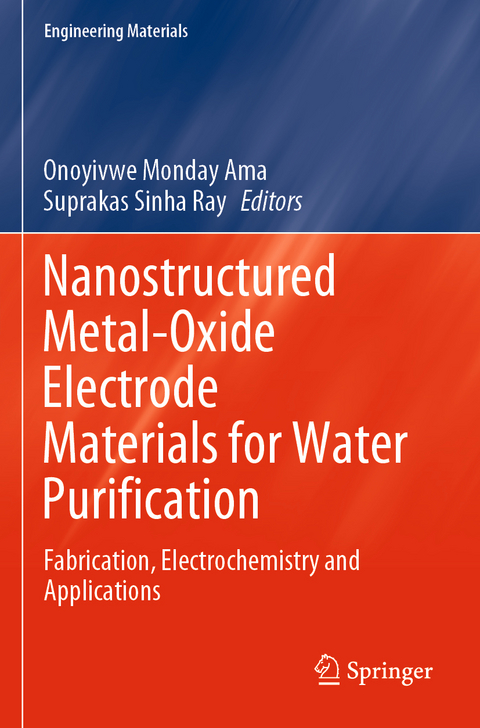
Nanostructured Metal-Oxide Electrode Materials for Water Purification
Springer International Publishing (Verlag)
978-3-030-43348-2 (ISBN)
This book reports on the development of nanostructured metal-oxide-based electrode materials for use in water purification. The removal of organic pollutants and heavy metals from wastewater is a growing environmental and societal priority. This book thus focuses primarily on new techniques to modify the nanostructural properties of various solvent-electrolyte combinations to address these issues. Water treatment is becoming more and more challenging due to the ever increasing complexity of the pollutants present, requiring alternative and complementary approaches toward the removal of toxic chemicals, heavy metals and micro-organisms, to name a few. This contributed volume cuts across the fields of electrochemistry, water science, materials science, and nanotechnology, while presenting up-to-date experimental results on the properties and synthesis of metal-oxide electrode materials, as well as their application to areas such as biosensing and photochemical removal of organicwastewater pollutants. Featuring an introductory chapter on electrochemical cells, this book is well positioned to acquaint interdisciplinary researchers to the field, while providing topical coverage of the latest techniques and methodology. It is ideal for students and research professionals in water science, materials science, and chemical and civil engineering.
lt;p>
Dr. Onoyivwe Monday Ama received his Ph.D. in Chemistry from the University of Johannesburg, South Africa in 2017. His research activities encompass the areas of electrochemistry, water science, materials science, and nanotechnology, with a focus on the applicability of exfoliated graphite nanocomposites in electrochemical technology. He has published a number of peer-reviewed papers in journals such as the Journal of Electroanalytical Chemistry, Electrocatalysis and the International Journal of Eletrochemical Science.
Professor Suprakas Sinha Ray received his PhD in Physical Chemistry from the University of Calcutta in 2001, and is currently a chief researcher on polymer nanocomposites at the Council for Scientific and Industrial Research (CSIR), Pretoria, South Africa, and manager of the Centre for Nanostructures and Advanced Materials, DSI-CSIR Nanotechnology Innovation Centre. Prof. Ray's current research focuses on polymer-based advanced nanostructured materials and their applications. He is one of the most active and highly cited authors in the field of polymer nanocomposite materials and was recently rated by Thomson Reuters as one of the world's most impactful and influential scientists and among the top 50 high-impact chemists (out of 2 million chemists worldwide). He has co-authored 3 edited books and authored 4 books and 30 book chapters on various aspects of polymer-based nano-structured materials & their applications; he has also co-authored or authored 350 articles in high-impact international journals and 30 articles in national and international conference proceedings. He holds 6 patents, and he and his research team have commercially developed 19 different products. His honors and awards include the prestigious 2016 South Africa National Science and Technology Award (NSTF), the 2014 CSIR-wide Leadership Award, the 2014 CSIR Human Capital Development Award, the 2013 Morand Lambla Award (top award in the field of polymer processing worldwide), and an award from the International Polymer Processing Society, USA. He also serves as an Extraordinary Professor at the University of Pretoria and as a Distinguished Visiting Professor at the University of Johannesburg.
The dynamic degradation efficiency of major organic pollutants from wastewater.- Synthesis and fabrication of photoactive nanocomposite electrodes for the degradation of wastewater pollutants.- The essence of electrochemical measurements on corrosion characterization and electrochemistry application.- Electrochemical cells.- Properties and synthesis of metal oxide nanoparticles in electrochemistry.- Metal oxide nanomaterials for biosensor application.- Metal oxide nanomaterials for electrochemical detection of heavy metals in water.- Application of metal oxides electrodes.- Application of modified metal oxide electrodes in photoelectrochemical removal of organic pollutants from wastewater.- Metal oxide nanocomposites for adsorption and photoelectrochemical degradation of pharmaceutical pollutants
| Erscheinungsdatum | 09.04.2021 |
|---|---|
| Reihe/Serie | Engineering Materials |
| Zusatzinfo | XV, 193 p. 60 illus., 43 illus. in color. |
| Verlagsort | Cham |
| Sprache | englisch |
| Maße | 155 x 235 mm |
| Gewicht | 332 g |
| Themenwelt | Naturwissenschaften ► Chemie ► Physikalische Chemie |
| Technik ► Maschinenbau | |
| Technik ► Umwelttechnik / Biotechnologie | |
| Schlagworte | Electrochemical Detection of Heavy Metals • Metal Oxide Biosensors • Nanostructured Metal Oxide Electrodes • Photoactive Nanocomposite Electrodes • Photochemical Degradation • Wastewater Pollutants • water industry and water technology • Water Quality and Water Pollution |
| ISBN-10 | 3-030-43348-X / 303043348X |
| ISBN-13 | 978-3-030-43348-2 / 9783030433482 |
| Zustand | Neuware |
| Haben Sie eine Frage zum Produkt? |
aus dem Bereich


